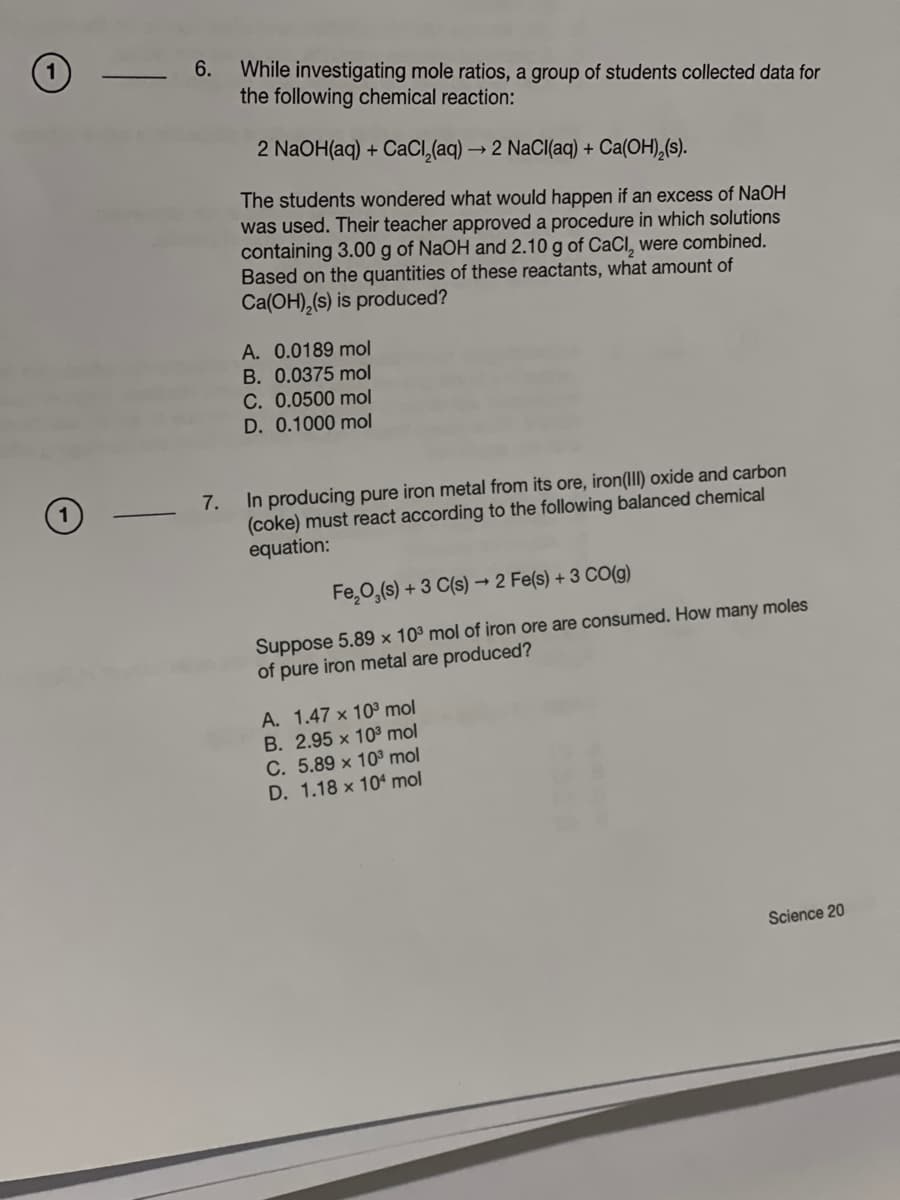6. While investigating mole ratios, a group of students collected data for the following chemical reaction: 2 NaOH(aq) +CaCl₂(aq) → 2 NaCl(aq) + Ca(OH)₂(s). The students wondered what would happen if an excess of NaOH was used. Their teacher approved a procedure in which solutions containing 3.00 g of NaOH and 2.10 g of CaCl, were combined. Based on the quantities of these reactants, what amount of Ca(OH)₂(s) is produced? A. 0.0189 mol B. 0.0375 mol C. 0.0500 mol D. 0.1000 mol
6. While investigating mole ratios, a group of students collected data for the following chemical reaction: 2 NaOH(aq) +CaCl₂(aq) → 2 NaCl(aq) + Ca(OH)₂(s). The students wondered what would happen if an excess of NaOH was used. Their teacher approved a procedure in which solutions containing 3.00 g of NaOH and 2.10 g of CaCl, were combined. Based on the quantities of these reactants, what amount of Ca(OH)₂(s) is produced? A. 0.0189 mol B. 0.0375 mol C. 0.0500 mol D. 0.1000 mol
Chemistry for Engineering Students
4th Edition
ISBN:9781337398909
Author:Lawrence S. Brown, Tom Holme
Publisher:Lawrence S. Brown, Tom Holme
Chapter4: Stoichiometry
Section: Chapter Questions
Problem 4.69PAE: 4.69 The pictures below show a molecular-scale view of a chemical reaction between H2 and CO to...
Related questions
Question
100%

Transcribed Image Text:6.
While investigating mole ratios, a group of students collected data for
the following chemical reaction:
2 NaOH(aq) + CaCl₂(aq) → 2 NaCl(aq) + Ca(OH)₂(s).
The students wondered what would happen if an excess of NaOH
was used. Their teacher approved a procedure in which solutions
containing 3.00 g of NaOH and 2.10 g of CaCl, were combined.
Based on the quantities of these reactants, what amount of
Ca(OH)₂(s) is produced?
A. 0.0189 mol
B. 0.0375 mol
C. 0.0500 mol
D. 0.1000 mol
7.
In producing pure iron metal from its ore, iron(III) oxide and carbon
(coke) must react according to the following balanced chemical
equation:
Fe₂O₂ (s) + 3 C(s) → 2 Fe(s) + 3 CO(g)
Suppose 5.89 x 10³ mol of iron ore are consumed. How many moles
of pure iron metal are produced?
A. 1.47 x 10³ mol
B. 2.95 x 103³ mol
C. 5.89 x 10³ mol
D. 1.18 x 104 mol
Science 20
Expert Solution
This question has been solved!
Explore an expertly crafted, step-by-step solution for a thorough understanding of key concepts.
This is a popular solution!
Trending now
This is a popular solution!
Step by step
Solved in 2 steps

Knowledge Booster
Learn more about
Need a deep-dive on the concept behind this application? Look no further. Learn more about this topic, chemistry and related others by exploring similar questions and additional content below.Recommended textbooks for you

Chemistry for Engineering Students
Chemistry
ISBN:
9781337398909
Author:
Lawrence S. Brown, Tom Holme
Publisher:
Cengage Learning

Chemistry: The Molecular Science
Chemistry
ISBN:
9781285199047
Author:
John W. Moore, Conrad L. Stanitski
Publisher:
Cengage Learning

Chemistry
Chemistry
ISBN:
9781305957404
Author:
Steven S. Zumdahl, Susan A. Zumdahl, Donald J. DeCoste
Publisher:
Cengage Learning

Chemistry for Engineering Students
Chemistry
ISBN:
9781337398909
Author:
Lawrence S. Brown, Tom Holme
Publisher:
Cengage Learning

Chemistry: The Molecular Science
Chemistry
ISBN:
9781285199047
Author:
John W. Moore, Conrad L. Stanitski
Publisher:
Cengage Learning

Chemistry
Chemistry
ISBN:
9781305957404
Author:
Steven S. Zumdahl, Susan A. Zumdahl, Donald J. DeCoste
Publisher:
Cengage Learning


Chemistry: An Atoms First Approach
Chemistry
ISBN:
9781305079243
Author:
Steven S. Zumdahl, Susan A. Zumdahl
Publisher:
Cengage Learning

General Chemistry - Standalone book (MindTap Cour…
Chemistry
ISBN:
9781305580343
Author:
Steven D. Gammon, Ebbing, Darrell Ebbing, Steven D., Darrell; Gammon, Darrell Ebbing; Steven D. Gammon, Darrell D.; Gammon, Ebbing; Steven D. Gammon; Darrell
Publisher:
Cengage Learning